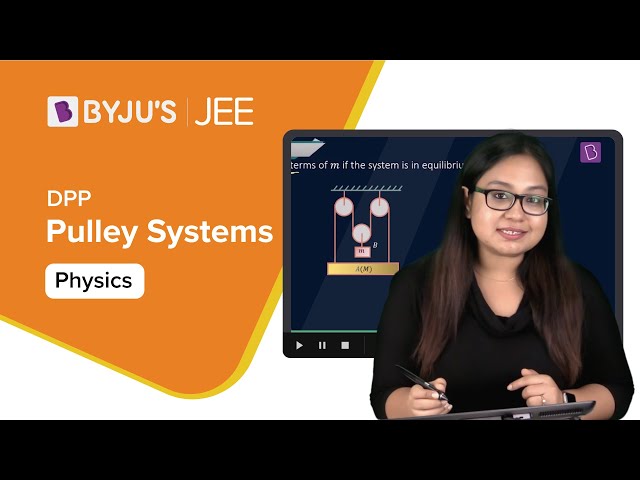Here, we will look at some problems based on the pulley and learn how to solve them. Also, we will understand a few equations involved and the method of applying them in solving different problems.
Pulley Problems and Constraint Equation Videos
Pulley Problems

Concept Based on Rotation of Pulley

Constraint Relation for Strings

Finding Tension in the Rope

Pulley Systems DPP

Atwood Machine

How to Solve Pulley Problems?
For solving any pulley problem, the first step is to understand the given conditions and write down the constraint equations accordingly.
CASE – 1

Let M1 & M2 be the mass attached to pulley A. Now, consider that mass M1 is moving down with acceleration a1 and mass M2 is moving up with acceleration a2.
Now, from the Free Body Diagram (FBD):

The equation of force from FBD:
M1.g – T = M1.a1 . . . . . . . . . . (1)
T – M2.g = M2.a2 . . . . . . . . . . . (2)
From the above force equation, we have three unknown values, but there are only two equations (Equation (1) & Equation (2)), so we need a third equation relating the two unknowns. The relation is known as the constraint equation because the motion of M1 and M2 is interconnected.
The following assumptions must be considered before writing the equation:
1. The string is taut and inextensible at each and every point in time.
2. The string is massless, and hence the tension is uniform throughout.
3. Pulley is massless.
The string is inextensible; hence the total change in length of the string should be zero. Suppose mass M1 goes down by x1 distance and mass M2 moves up by x2 distance. Then, change in length = x1 – x2 (Taking elongation as positive and compression as negative).
On equating it to zero, we get, x1 – x2 = 0 (x = displacement)
On differentiating equation twice, we get,
a1 – a2 = 0 . . . . . . . . . (3) (a = acceleration)
Using Equations (1), (2) and (3), we can calculate the values of T, a1 and a2. This is an example of a Fixed Pulley System.
CASE – 2
Consider the following pulley system:

First, we have to relate the tension between string 1 and string 2; consider the FBD of pulley B:

2T1 – T 2 = MB.aB
2T1 = T2 . . . . . . . . . (4) (Since the pulley is massless)
Now, consider the accelerations, as shown in the below figure:

For String 2:
Movable pulley B and block M2 will have the same acceleration, otherwise, the string will stretch or compress.
aB = a2 . . . . . . . . . . . . (5)
Increase in length to the left of fixed pulley A = L1
Decrease in length to the right of fixed pulley A = L2
Decrease in length to the right of movable pulley B = L3
And, L1 + L2 + L3 = Constant.
Therefore, the total change in length = L1 – 2L2 (Since L2 = L3)
On differentiating the above equation twice, we get,
⇒ a1 = 2a2 . . . . . . . . (6)
Similarly, if we write the force equation on both blocks:
M1.g – T = M1.a1 . . . . . . . . . . (7)
2T – M2.g = M2.a2 . . . . . . . . . (8)
Using Equations (6), (7) and (8), we get,
Instead of using the above method, we can also use a shortcut to find the constraint relationship for saving time in JEE.
If we consider all the blocks + pulleys + string as one system, then the tension becomes an internal force, and we know that the work done by the internal force is zero.
Work done by tension on block M1 = -T.x1
Work done by tension on block M2 = 2T.x2
Work by tension on pulley A = T.0 = 0
Work done by tension on pulley B = 2T.x2 – 2T.x2 = 0
Hence, we get 2T.x2 – T.x1 = 0
⇒ x1 = 2.x2
Differentiating twice with respect to time, we get,
⇒ a1 = 2.a2
The above technique can be used in almost all possible pulley systems, consisting of fixed pulleys or movable pulleys.
Stay tuned to BYJU’S to learn more about the laws of motion.
More Pulley Problem Videos
Pulley Systems

Problem-based on Pulley-mass System (No-slip condition)


Comments